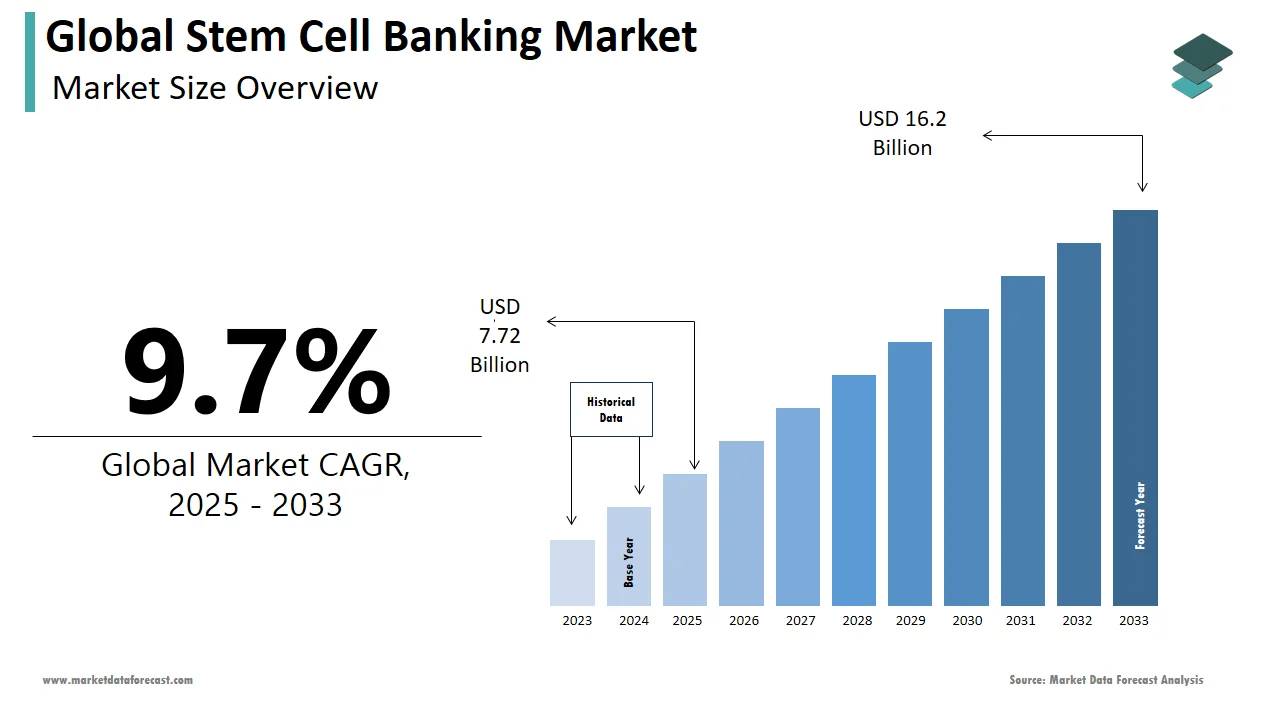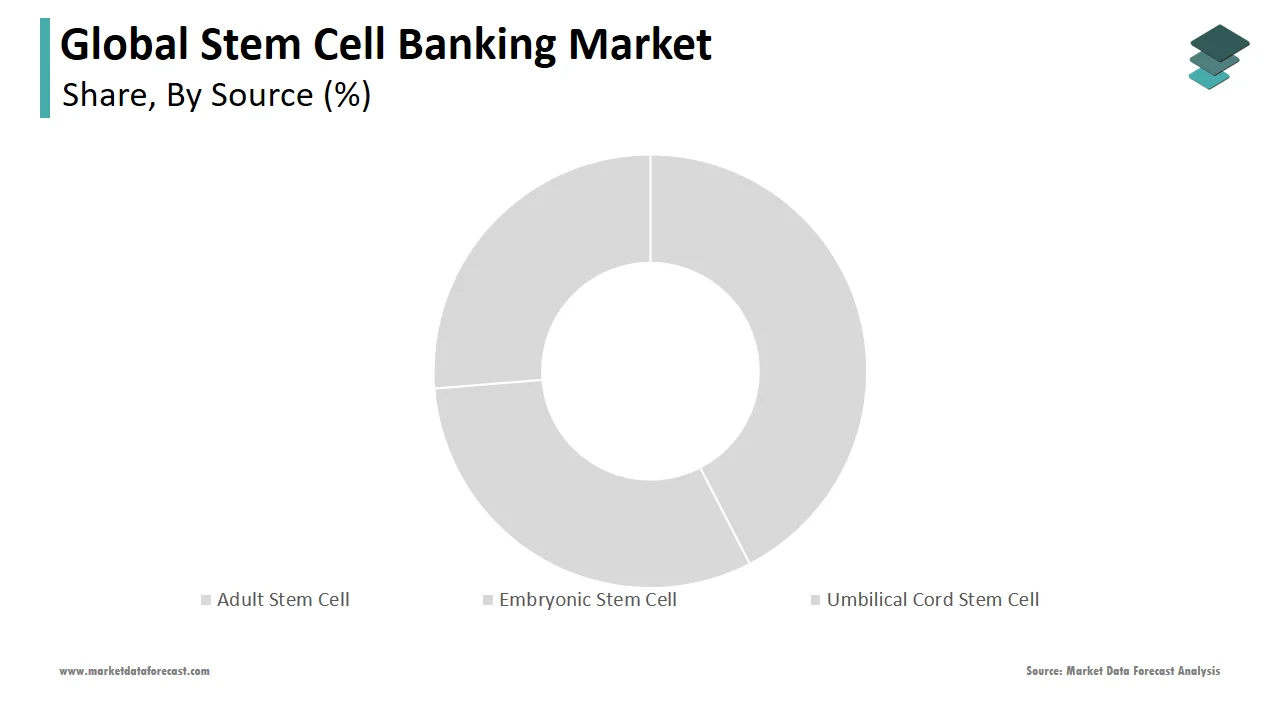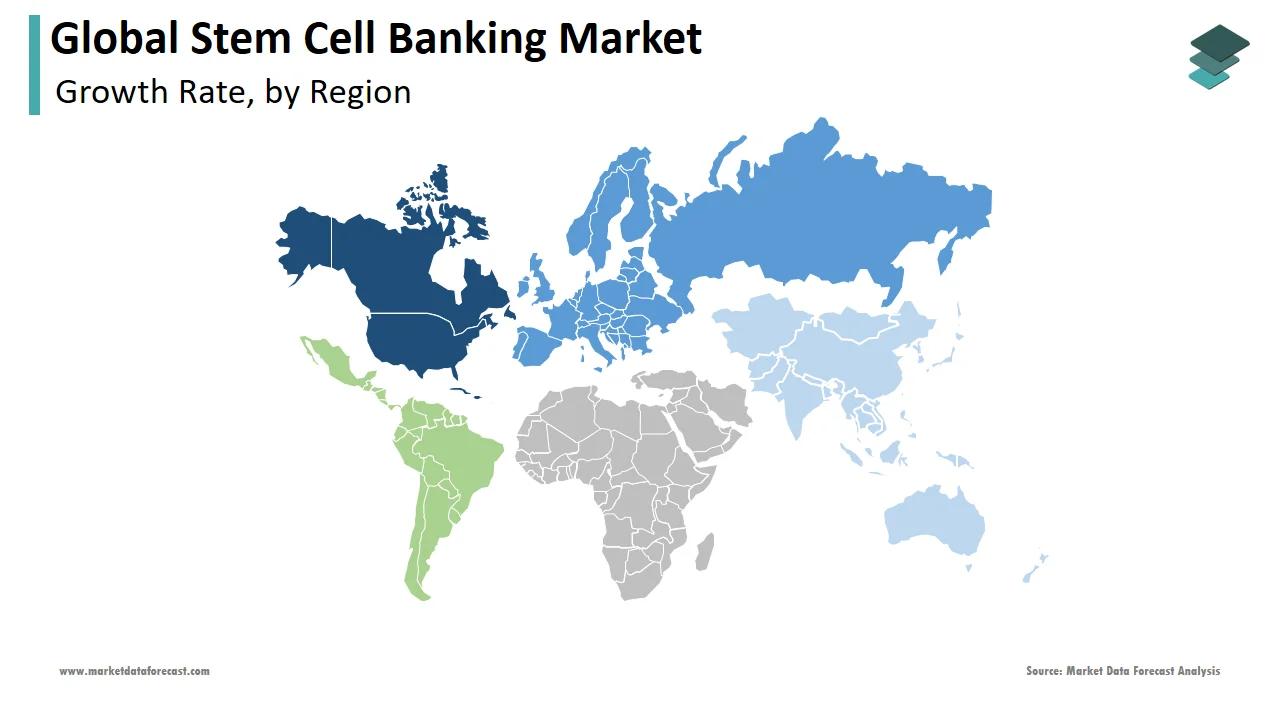Global Stem Cell Banking Market Size, Share, Trends & Growth Forecast Report By source, service type, application, and Region (North America, Europe, Asia-Pacific, Latin America, Middle East and Africa), Industry Analysis From 2025 To 2033.
Global Stem Cell Banking Market Size
The global stem cell banking market was worth US$ 7.04 billion in 2024 and is anticipated to reach a valuation of US$ 16.2 billion by 2033 from US$ 7.72 billion in 2025, and it is predicted to register a CAGR of 9.7% during the forecast period 2025-2033.

The use of stem cells in cell therapy, regenerative medicine, drug discovery, toxicity, and developmental biology research is very promising. Stem cell banks have been increasingly established all over the world to preserve their cellular characteristics, prevent contamination and deterioration, and facilitate their effective use in basic and translational research, as well as current and future clinical applications.
Furthermore, many stem cells come from once-in-a-lifetime tissues. For instance, cord blood that was once wasted can now be used to treat a variety of illnesses, including blood malignancies. Meanwhile, these cells stored and often banked for long periods can be immediately available for treatment when needed and early treatment can minimize disease progression. The banking stem cell is an extension of biobanking. The term "biobanking" has been used extensively to refer to the practice of keeping biological materials, genetic data, and/or health information in repositories, banks, or collections. This market is a significant one in the healthcare sector because of the changing environment and knowledge of the value of stem cell banking. The top 10 banks in the world store more than 4 million units of cord blood and cord tissue, according to the Cord Blood Organisation. Therefore, these top 10 businesses (such as California Cryobank Co., LifeCell, Global Cord Blood Corporation, Cordlife Group, etc.) are in charge of managing more than 60% of the world's privately banked newborn stem cells.
MARKET DRIVERS
The stem cell banking market is driven by a confluence of factors that highlight the remarkable potential of stem cells in regenerative medicine. However, the growing awareness about stem cell preservation, storage, and the escalating investment and funding for stem cell research are key drivers for market revenue growth.
In recent years, the significance of stem cells in regenerative medicine and tissue engineering has grown exponentially. The potential to harness the power of stem cells to regenerate damaged tissues and organs has captured the attention of researchers, clinicians, and patients worldwide. Stem cell preservation and storage is becoming increasingly important, as stem cells have the potential to treat a wide range of diseases. Stem cell banking facilities provide a safe and reliable way to store these precious cells for future use. Recognizing this immense potential, individuals and families are becoming more conscious of the importance of preserving their own stem cells for future use. Stem cell banking facilities provide a secure and reliable means to store these precious cells. Governments, private investors, and philanthropic organizations have recognized the immense promise of stem cells in revolutionizing medical treatments. As a result, funding initiatives are actively accelerating stem cell therapy development. This capital influx fuels the expansion of stem cell banking facilities, enhancing their capabilities.
A compelling driver for the stem cell banking market is the high number of clinical trials utilizing stem cells to address over 80 chronic and life-threatening diseases and conditions. Stem cell-based therapies have demonstrated encouraging outcomes in clinical settings, offering potential cures and improved treatment options for ailments such as cancer, cardiovascular diseases, neurodegenerative disorders, and genetic disorders. The remarkable progress in these clinical trials has braced confidence in the efficacy and safety of stem cell therapies, further driving the demand for stem cell banking services.
The increase in medical applications of stem cells has opened up new pathways for treating chronic and critical diseases, including Alzheimer's, cerebral palsy, and autism, which currently lack a cure. This breakthrough in medical science is expected to drive the revenue growth of the stem cell banking market during the forecast period. Collaborations and partnerships between stem cell banks, research institutions, and healthcare providers will likely drive market opportunities. These collaborations facilitate the development of cutting-edge therapies, clinical trials, and research studies, accelerating progress in regenerative medicine. The increasing emphasis on personalized medicine and the integration of stem cell therapies into mainstream healthcare systems can also be an opportunity for market growth.
MARKET RESTRAINTS
The key market restraints when setting up the bank include defining the scope of the work, which includes the numbers and types of cell lines to be banked, and determining the number of people who will work in the bank and their specific tasks. When storing different cell types in the same bank, precautions should be taken, such as installing safeguards to prevent cross-contamination. Additionally, a physical environment where air quality (i.e., the number of airborne particles) is controlled is needed for the processing of stem cells, including isolation, culture, and collecting. The design and operation of the processing facility should reduce the introduction, production, and retention of particles and microorganisms.A successful stem cell biobank requires the implementation of the groundwork for efficient storage, quality monitoring and assessment, and long-term maintenance and management. This market requires high-cost investment, efficient quality storage and proper handling by trained professionals. Ethical issues also become a challenge. The concerns over the use of human embryos are to be expected wherever work on gametes is proposed. The ability to guarantee donor anonymity is also an area for careful consideration.
Impact of COVID-19 on the Global Stem Cell Banking Market
The COVID-19 pandemic has created a sense of urgency to generate new drugs and vaccines. This urgency has led to a reduction in the quality of medical research, as well as overhype and rushed development of certain treatments, including cell-based therapies often sold as “stem cell” treatments. While some of these products have undergone well-designed, adequately controlled trials, most are in the early stages. Some clinics are nevertheless offering these unproven and unlicensed treatments to people, promising to boost their immune system or overall health to protect against COVID-19. Health experts have documented adverse events due to unlicensed “stem cell” products, including vision loss and autoimmune, infectious, neurological, and cardiovascular complications.However, there have also been some positive developments. Researchers have used heart and lung stem cells infected with the virus that causes COVID-19 to better understand how the disease impacts different organs, paving the way for more targeted treatments. The study also looked at approved drugs for treating COVID-19, including Remdesivir and Molnupiravir, with some found to be more effective than others at treating infection in lung and heart stem cells. It identified Alectinib and SPHINX31 as promising antivirals for SARS-CoV-2 in both heart and lung cells. This concludes the COVID-19 pandemic has led to a mixed bag of results when it comes to the development of new treatments. While there have been some promising advances, there have also been some serious concerns about the safety and efficacy of unproven treatments. It is important to be aware of the risks and benefits of any treatment before undergoing it and to only seek treatment from reputable providers.
REPORT COVERAGE
|
REPORT METRIC |
DETAILS |
|
Market Size Available |
2024 to 2033 |
|
Base Year |
2024 |
|
Forecast Period |
2025 to 2033 |
|
CAGR |
9.7% |
|
Segments Covered |
By Source, Service Type, Application, and Region. |
|
Various Analyses Covered |
Global, Regional, and country-level analysis; Segment-Level Analysis, DROC; PESTLE Analysis; Porter’s Five Forces Analysis, Competitive Landscape; Analyst Overview of Investment Opportunities |
|
Regions Covered |
North America, Europe, APAC, Latin America, Middle East & Africa |
|
Market Leaders Profiled |
Cryo-Cell International, Inc., Smart Cells International Ltd., CSG-BIO Company, Inc., CBR Systems Inc., ViaCord, LifeCell International Pvt. Ltd., StemCyte India Therapeutics Pvt. Ltd, Global Cord Blood Corporation, Caladrius Biosciences, Inc., Celgene Corporation, BrainStorm Cell Limited, Regrow Biosciences Pvt. Ltd., CryoHoldco, Cryo-Save., and Others. |
SEGMENTAL ANALYSIS
By Source Insights

Umbilical Cord Stem Cells has been a leading player in the stem cell banking market since 2020. It is expected to grow even more during the forecast period because of the high demand for stem cells to treat blood cancer where treatment of blood disorders, regenerative medicine, immunotherapy, research & drug development, and cord blood banking are required. The second player could be adult stem cell which is also gaining a lot of attention due to the demand for tissue repair and regeneration, organ transplantation, etc.
By Service Type Insights
The leading segment is preservation & storage, which plays a critical role in stem cell banking, followed by the processing segment which includes all the necessary measures like testing, stem cell isolation, cryopreservation & retrieval.
By Application Insights
Personalized banking is forecasted to occupy the largest share of the stem cell banking market by registering a healthy growth rate during the forecast period, followed by clinical application.
REGIONAL ANALYSIS

North America holds most of the market share in stem cell banking, because of advanced technology and innovative measures for preservation and storage, followed by the European stem cell banking market with the initiative by European Union saw an increased demand for cord blood banking.
KEY MARKET PLAYERS
Cryo-Cell International, Inc., Smart Cells International Ltd., CSG-BIO Company, Inc., CBR Systems Inc., ViaCord, LifeCell International Pvt. Ltd., StemCyte India Therapeutics Pvt. Ltd, Global Cord Blood Corporation, Caladrius Biosciences, Inc., Celgene Corporation, BrainStorm Cell Limited, Regrow Biosciences Pvt. Ltd., CryoHoldco, Cryo-Save.
RECENT MARKET HAPPENINGS
- In Jun 2023, Cell Freezing Medium Market: Cell Freezing Mediums Play a Vital Role in Cell Preservation and Cryopreservation, Stimulating Market Demand in Biobanking, Stem Cell Research, and Cell-based Therapies
- In Jun 2023, In a major breakthrough in the world of In Vitro Fertilisation (IVF) and human reproduction, a team of scientists in the US and the UK has developed the world's first-ever synthetic human embryo-like structures using stem cells.
- In Mar 2023, An innovative new robot that grows stem cells, the CellQualiaTM Intelligent Cell Processing System, is being trialled by the Medicines and Healthcare Products Regulatory Agency (MHRA). This robotic system has the potential to bring safer and more cost-effective treatments to people with a wide range of diseases. It is currently the only one in the world outside of Japan, where it was developed.
- In Aug 2022, Stem Cell Lines Riddled With Undetected Mutations: Most of the human induced pluripotent stem cells stored at major cell line repositories and used in research harbour thousands of DNA errors, a study finds, highlighting the need for improved quality control measures.
MARKET SEGMENTATION
This research report on the stem cell banking market can be segmented and sub-segmented based on source, service type, application, and region.
By Source
- Adult Stem Cell
- Embryonic Stem Cell
- Umbilical Cord Stem Cell
- Cord Blood
- Cord Tissue
- Placenta
By Service Type
- Preservation & Storage
- Analysis
- Processing
- Collection & Transportation
By Application
- Personalized Banking Applications
- Research Application
- Drug discovery
- Life Science Research
- Clinical Application
- Hematopoietic Disorder
- Auto-immune Disorder
- Others
By Region
- North America
- Europe
- Asia-Pacific
- Latin America
- The Middle East and Africa
Frequently Asked Questions
What will be size of the stem cell banking market worth by 2033?
The size of the global stem cell banking market is predicted to be worth 16.2 billion USD by 2033.
Which region is accounted for the largest market share during the forecast period?
The North America region accounted for the largest market share during the forecast period from 2025 to 2033.
Which segment by source is predicted to account for the largest share during the forecast period?
By source, the placental stem cells segment is predicted to account for the largest share during the forecast period 2025 to 2033.
Who are the key market players of the global stem cell banking market?
Prominent companies leading the global stem cell banking market profiled in the report are Cord Blood Registry Systems, Cordlife, Cryo-Cell International, Cryo-Save AG, LifeCell International, StemCyte, ViaCord, Global Cord Blood, Smart Cells International, Vita34, and CryoHoldco.,
Related Reports
Access the study in MULTIPLE FORMATS
Purchase options starting from
$ 2500
Didn’t find what you’re looking for?
TALK TO OUR ANALYST TEAM
Need something within your budget?
NO WORRIES! WE GOT YOU COVERED!
Call us on: +1 888 702 9696 (U.S Toll Free)
Write to us: sales@marketdataforecast.com
